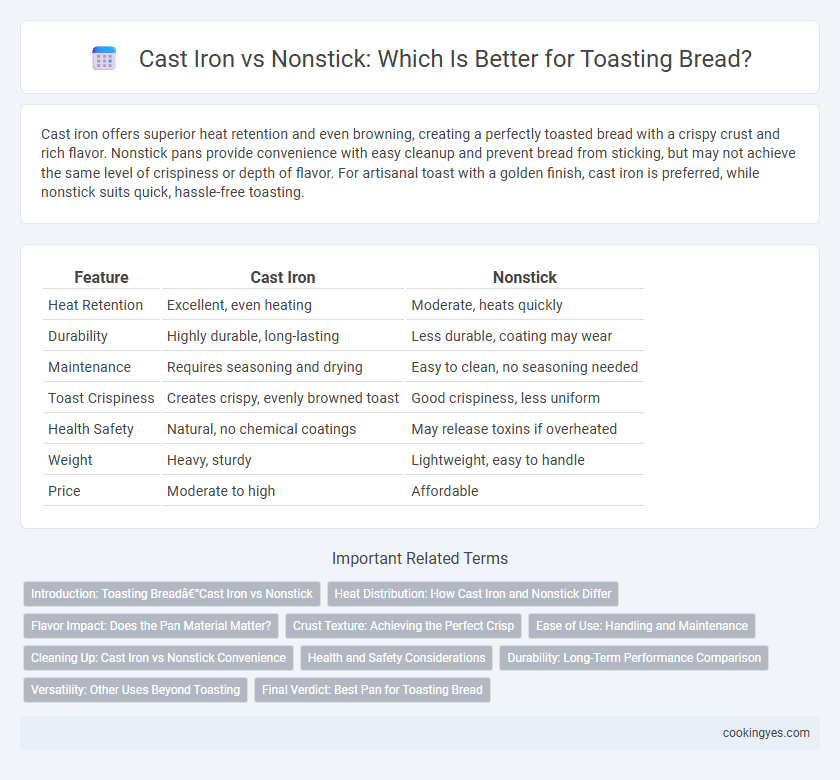Cast iron offers superior heat retention and even browning, creating a perfectly toasted bread with a crispy crust and rich flavor. Nonstick pans provide convenience with easy cleanup and prevent bread from sticking, but may not achieve the same level of crispiness or depth of flavor. For artisanal toast with a golden finish, cast iron is preferred, while nonstick suits quick, hassle-free toasting.
Table of Comparison
| Feature | Cast Iron | Nonstick |
|---|---|---|
| Heat Retention | Excellent, even heating | Moderate, heats quickly |
| Durability | Highly durable, long-lasting | Less durable, coating may wear |
| Maintenance | Requires seasoning and drying | Easy to clean, no seasoning needed |
| Toast Crispiness | Creates crispy, evenly browned toast | Good crispiness, less uniform |
| Health Safety | Natural, no chemical coatings | May release toxins if overheated |
| Weight | Heavy, sturdy | Lightweight, easy to handle |
| Price | Moderate to high | Affordable |
Introduction: Toasting Bread—Cast Iron vs Nonstick
Toasting bread in a cast iron skillet provides even heat distribution and creates a crispy, golden crust with rich flavor due to its superior heat retention. Nonstick pans offer convenience with easy release and minimal oil usage, making cleanup simpler while producing a uniformly toasted surface. Choosing between cast iron and nonstick depends on desired texture, cooking time, and maintenance preference for optimal bread-toasting results.
Heat Distribution: How Cast Iron and Nonstick Differ
Cast iron provides superior heat distribution for toasting bread, ensuring even browning and a consistent crisp texture due to its high thermal mass. Nonstick pans heat up quickly but often deliver uneven heat, resulting in patchy toasting and less desirable crust formation. The durability of cast iron also allows it to maintain stable temperatures over time, enhancing the overall toasting quality compared to nonstick surfaces.
Flavor Impact: Does the Pan Material Matter?
Cast iron pans enhance the flavor of toasted bread by providing even heat distribution and retaining heat longer, which allows for a consistent, golden-brown crust with a slightly smoky, rich flavor. Nonstick pans prevent sticking and require less oil or butter, preserving the bread's natural taste but often result in a less caramelized, softer crust. The pan material significantly influences the toasting process and final flavor profile, with cast iron offering a more robust and complex taste experience compared to nonstick surfaces.
Crust Texture: Achieving the Perfect Crisp
Cast iron skillets deliver superior heat retention, producing an evenly crisped crust with a satisfying crunch, ideal for achieving the perfect toasted bread texture. Nonstick pans offer ease of use and quick release but may result in a softer crust due to less intense heat distribution. The heavy surface of cast iron promotes Maillard reaction, enhancing both the flavor depth and crispy exterior on toasted slices.
Ease of Use: Handling and Maintenance
Cast iron toasting pans offer superior heat retention and durability but require seasoning and careful cleaning to prevent rust, making maintenance more demanding. Nonstick pans provide effortless bread release and easy cleaning with just mild detergents, enhancing daily usability. Handling cast iron involves dealing with a heavier weight and potential hot spots, while nonstick cookware is lighter and generally more user-friendly for quick toasting tasks.
Cleaning Up: Cast Iron vs Nonstick Convenience
Cast iron skillets require seasoning and thorough drying to prevent rust, making cleanup more involved compared to nonstick surfaces. Nonstick pans allow for easier cleaning due to their smooth, coated surfaces that resist food sticking and generally need only gentle wiping or light washing. Choosing between cast iron and nonstick for toasting bread depends largely on the desired maintenance effort and convenience in cleanup.
Health and Safety Considerations
Cast iron skillets offer a natural, chemical-free surface that can withstand high temperatures without releasing harmful toxins, making them a safer choice for toasting bread compared to some nonstick pans that may emit toxic fumes when overheated. Nonstick cookware often contains perfluorinated compounds like PFOA or PTFE, which pose health risks if the coating is scratched or degraded during use. Regular seasoning of cast iron enhances its nonstick properties while minimizing the risk of contamination, ensuring a healthier toasting experience.
Durability: Long-Term Performance Comparison
Cast iron toasters offer exceptional durability, with their robust construction resisting warping and chipping over years of use, making them ideal for long-term performance. Nonstick toasters feature coatings that can degrade or peel with frequent use and high heat exposure, potentially reducing their lifespan. For sustained toasting quality and longevity, cast iron remains the superior choice in terms of durability.
Versatility: Other Uses Beyond Toasting
Cast iron skillets offer exceptional versatility beyond toasting bread, excelling at searing meats, baking, and frying, thanks to their superior heat retention and durability. Nonstick pans provide ease of use for delicate tasks like cooking eggs or pancakes without sticking, but they are generally less suitable for high-heat applications or oven use. Choosing between cast iron and nonstick depends on the range of cooking techniques desired beyond simple toasting.
Final Verdict: Best Pan for Toasting Bread
Cast iron pans deliver superior heat retention and even browning, creating a perfectly toasted, crispy crust on bread. Nonstick pans offer easy cleanup and require less oil, making them convenient for quick, hassle-free toasting. For optimal texture and flavor, cast iron remains the best pan for toasting bread due to its consistent heat distribution and durability.
Cast Iron vs Nonstick for Toasting Bread Infographic

 cookingyes.com
cookingyes.com